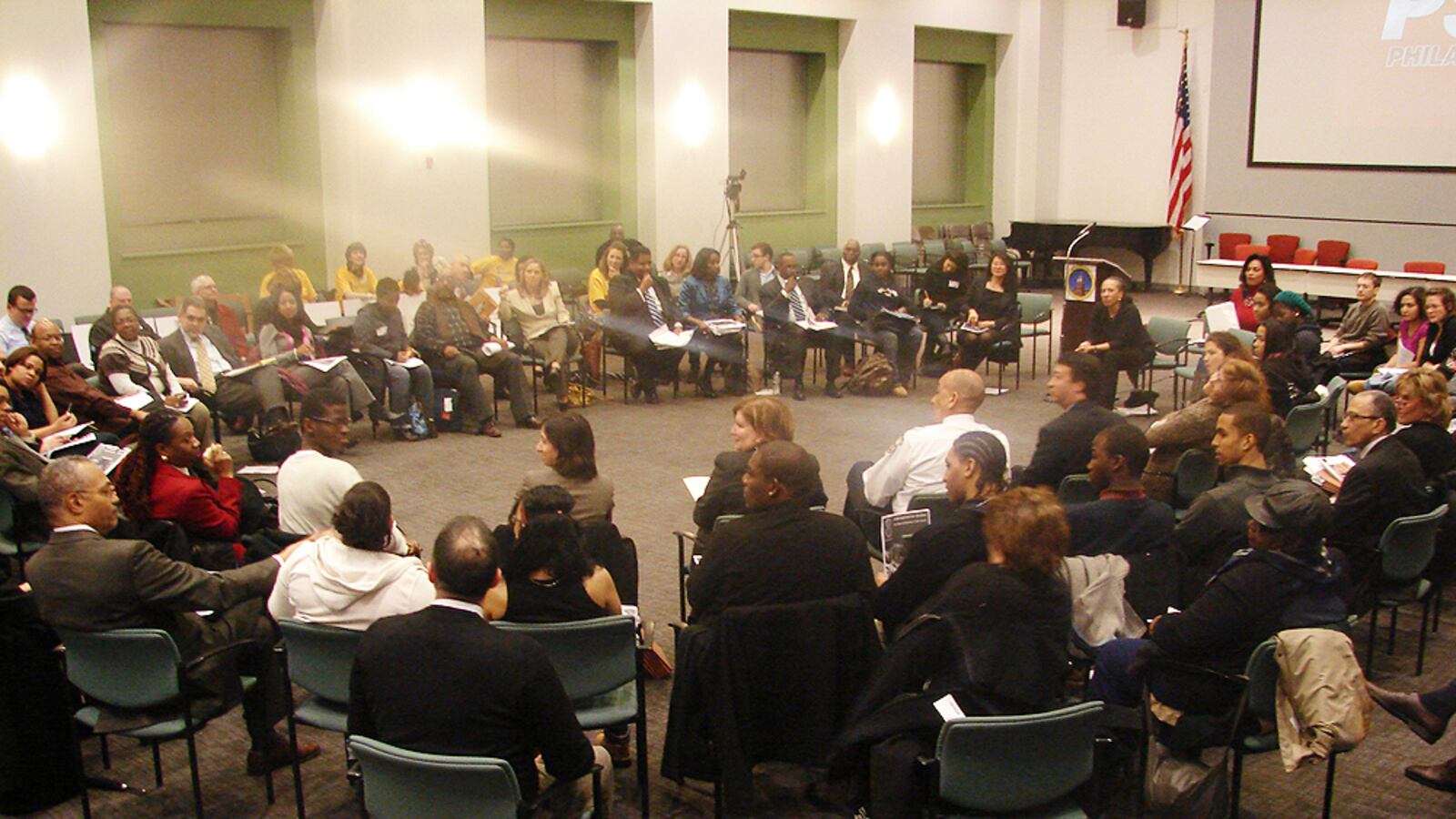This article was originally published in The Notebook. In August 2020, The Notebook became Chalkbeat Philadelphia.
by Benjamin Herold for the Notebook and WHYY/NewsWorks
A new committee of the School Reform Commission attempted Tuesday evening to tackle an old issue – school violence.
First, the SRC’s new Safety and Engagement Committee was presented with a report from the Blue Ribbon Commission on Safe Schools, originally convened more than a year ago by Philadelphia Mayor Michael Nutter and then-Superintendent Arlene Ackerman.
Then, Commissioner Lorene Cary chaired a free-form, talk-show style community discussion, asking all 70-plus individuals to introduce themselves. The audience sat in a circle, with District staff and SRC members scattered throughout. A basket of fruit was provided in the back of the auditorium. At one point, Cary even asked those in the room to take a deep breath together.
The new “strategy, policy, and priority” meeting format replaces what had been previously been known as SRC planning meetings.
Unchanged, however, is the District’s massive budget shortfall, which cast a pall over the Blue Ribbon Commission’s ambitious goals and recommendations for addressing the endemic violence in city schools. Principals are already dealing with eviscerated school budgets, and more cuts will be announced later this week.
“Often we say, ‘The SRC has cut everything there is, so what can we do?’” said Cary, “But the fact is we have to do it anyway.”
As a start, Cary announced the formation of a 14-member steering committee on safety, which includes both District officials and community members. The group plans to meet beginning in February.
Their first task will be to further review the Blue Ribbon Commission report, which outlines District failures ranging from the lack of adequate therapeutic counseling for students to “inconsistent reporting and tracking of serious incidents.” It also calls for a “public commitment” to building better relationships inside schools, collecting and reporting valid data on school violence, and implementing the report’s recommendations consistently across the District.
But the problems associated with school violence are no secret. In the past 24 months alone, the issue has spawned no fewer than six related reports, task forces, and commissions. In 2010, the District unveiled its Project Safe Schools, aimed at reducing the number of schools classified as persistently dangerous, increasing student attendance and reducing truancy, and decreasing the numbers of violent incidents and out-of-school suspensions in targeted schools.
Some progress has been made, officials said Tuesday.
Following a relaxing of the District’s zero-tolerance policy, there has been a significant drop in the number of student expulsions. Last year, the SRC voted on a total of 237 expulsion cases, but the commission has received only 11 cases so far this year.
“We have determined that it is a much more child-centered process [now], looking at the child in totality and all the circumstances that surrounded the incidents,” said District Deputy General Counsel Rachel Holzman.
There are also new procedures for reporting violent incidents and a new memorandum of understanding governing the relationship between the District and the Philadelphia Police Department. Eighty city officers are currently stationed in District schools, said Mayor Nutter, who was on hand Tuesday to lend his support to the initiative.
“This entire city must be focused on the critical issue of education and the critical issue of public safety in and around our schools,” said Nutter.
But overall, the rate of violent incidents reported districtwide has actually gone up 2 percent since last year. There is no net change at the 38 schools the District is watching most closely. Decreases in the rate of violent incidents at 23 of the District’s most challenging schools were offset by worsening rates at 15 other such schools.
Cary said that maintaining a focus on relationships and respect will be a challenge.
“We have a much more articulate vocabulary for punishment and monitoring than we do for prevention and repair,” said the acclaimed writer and educator.
The District also has a jumble of overlapping, often underutilized services. One exchange during the often-meandering audience discussion highlighted just how tricky it may prove to streamline and improve the District’s response to school violence.
After audience member Diana Casals suggested that the District implement school hotlines for reporting incidents and threats of violence, several District staff members responded that a citywide “bullying hotline” (215-400-SAFE) already exists.
New Safe Schools Advocate Kelley Hodge then added that her office also has a 24-hour hotline, though she couldn’t immediately remember the new phone number (1-877-730-6315).
Confused, Cary asked why there were two different hotlines covering the same issue, prompting an extended conversation.
“Clearly, we need to do a better job,” concluded the commissioner.
The SRC will hold its January voting meeting Thursday evening. Future SRC committee meetings will take place on the third Monday of every month.


